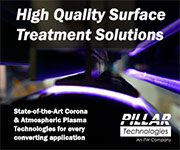Extrusion Coating Technology For The Imaging Industry
- Published: April 01, 2001, By by Thomas Bezigian Great Lakes Technologies, LLC email: tombezig@aol.com
Application: Extrusion coating is a process that can meet demanding applications such as photographic paper and other imaging uses.
Extrusion coating began in 1949. Initial applications involved polyethylene extrusion for “locker” or butcher paper followed by milk cartons. Additional applications that developed were sack or bag kraft, sachet packages and pouches, and various industrial and building applications. Time also saw the development of new polymeric materials such as polypropylene, polyester, and many copolymers of polyethylene. In the early 1970s, a resin coated base paper became available for photographic paper.
Equipment modifications also became available in the extrusion process. A special die design can routinely produce a cross-direction coating weight profile variation less than 5%. An additional advantage of this die design is reduced streaking. This is critical in high quality, optical products such as photographic paper, digital imaging papers, thermal laminating film, and fabric transfer film.
Markets
The computer revolution permanently altered the way images were put to paper. The digital imaging or “ink jet” product designs were segmented based on image quality and price. The higher quality product was a resin-coated paper similar in design to photographic paper without the waterproof base.
Although most ink jet market use is on plain paper, some generalizations are possible regarding the resin coated ink jet market. Various marketing reports place the size of the annual, global, resin coated ink jet market at 500-600 million square feet. This is approximately 8,000 metric tons of product.
These products reach market in the following scenario. An extrusion coater supplies the resin-coated base paper to a coater who applies the receptive coating to the face side of the base paper. The coater can supply this semi-finished product to a distributor who can either rewind it into wide format rolls for the professional market or sheet it for the consumer market. Those coaters who perform this function are coater/distributors who take the base directly from an extrusion coater and sell it directly to the end market. Figure 1 is a typical resin-coated ink jet paper.
New Applications
With the need to reduce cost and the desire to maintain product quality, new developments allow heretofore unavailable options for a coater to explore. These options use new technology for the digital imaging market including coextrusion, new resins, adhesion promotion, and clean rooms. Such technologies provide improved ink jet bases, improved laminating film, and improved fabric transfer films.
For example, adhesion of laminating films of plain paper is not problematic since these materials have good chemical and physical adhesion properties to the ethylene vinyl acetate resin used in common laminating films. The traditional methods for ensuring adhesion of laminating films to resin-coated papers are the following:
- Elimination of over-laminating film
- Lamination of only the face side of the ink jet print
- Treating the surface of the back side of the resin
- Coated ink jet substrate by gel subbing.
Modern techniques that a coater/printer can use are as follows:
- Corona treatment as a primer
- Proper selection of layer or layers to achieve adhesion to the laminating film
- Proper selection of the laminating film to adhere to the back side of the ink jet print
- Combination of these approaches.
The use of a system approach in the digital imaging market whereby the ink jet substrate, the receptive layer, the ink jet ink, and the laminating film work together in harmony offers the base paper supplier, coater, distributor, coater/distributor, original equipment manufacturer, and end user unique opportunities for future development and performance. One can design a base paper with improved adhesion to a laminating film and a laminating film with improved adhesion to a particular ink system or even a particular color of ink. Figure 2 shows a possible new resin-coated base paper for evaluation.
A new base paper can be optimized for adhesion to laminating film, curl, etc., by selection of the appropriate material in the coextruded layers in the structure. One can also tailor the composition of the laminating film to promote adhesion to difficult to adhere ink jet colors.
Another growth market in the digital imaging market is the fabric transfer film market aimed at high end custom T-shirt design. This is an established market, but the renewed vigor with which coaters are looking to supply this market is encouraging from business and technological perspectives. These products are typically custom designed blends of polymers with unique melting point properties. Some materials are pigmented. This poses another challenger to the extrusion coating converter. Many products involve using a silicone release liner that is challenging for high-speed converters to handle.
Conclusion
The outlook for digital imaging products generally remains strong as the evolution of computer technology widens and gains acceptance. A question remains whether the growth of the resin-coated ink jet base market will increase as fast as the remainder of the market. The cost of the high quality resin-coated base itself exceeds that of the finished price of the plain papers. The market itself will decide over the next few years if the image quality achieved with resin-coated ink jet papers supports the price. As with any market, the likely outcome is that the resin-coated market segment will achieve only a portion of the total ink jet market.
Ink jet ink
Receptive coating sometimes with opacifier
Face side low density polyethylene (LDPE)
typically with pigment
Raw base paper
Back side high density polyethylene (HDPE)
Gel subbing
1. Typical resin-coated ink jet structure.
Ink jet ink
Receptive coating sometimes with opacifier
Coextruded structure: Face side LDPE, layer
2 with or without pigment
Face side LDPE, layer 1 with or without pigment
Raw base paper
Coextruded structure: Back side, layer 1 HDPE or other
Back side, layer 2 HDPE or other
Corona treated back side
2. Possible new resin coated ink jet structure.













